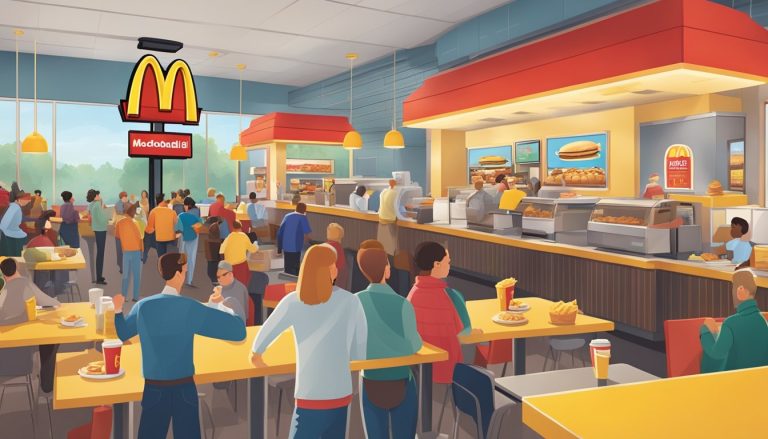McDonald’s breakfast has been a beloved staple for millions of customers since its introduction in the 1970s. The availability of breakfast items has evolved over the years, adapting to changing consumer preferences and market demands.
Currently, most McDonald’s restaurants in the United States serve breakfast from 5:00 am or 6:00 am until 10:30 am or 11:00 am daily. Some locations in busy urban areas or transportation hubs may start serving as early as 3:30 am to cater to early risers and night shift workers.
The story of McDonald’s breakfast is one of innovation and expansion. From the introduction of the Egg McMuffin to the addition of hotcakes, hash browns, and other morning favorites, the menu has grown to satisfy a wide range of tastes. While the dream of all-day breakfast has come and gone, the morning offerings continue to be a significant part of McDonald’s business and a popular choice for customers seeking a quick and convenient meal to start their day.
Origins of McDonald’s Breakfast
McDonald’s breakfast menu revolutionized fast food in the early 1970s. This innovation began with a single sandwich and quickly expanded into a diverse morning offering that changed American eating habits.
The Creation of the Egg McMuffin
The Egg McMuffin, McDonald’s first breakfast item, debuted in 1972. Herb Peterson, a McDonald’s franchise owner, invented this sandwich inspired by eggs benedict. He crafted it with an egg, Canadian bacon, and cheese on a toasted English muffin. Peterson presented his creation to McDonald’s CEO Ray Kroc, who immediately recognized its potential.
The Egg McMuffin’s popularity soared, prompting McDonald’s to consider a full breakfast menu. This single item laid the foundation for the company’s breakfast dominance in the fast food industry.
Expansion of the Breakfast Menu
Following the Egg McMuffin’s success, McDonald’s officially launched its breakfast menu in 1977. The expanded offerings included hotcakes, sausage biscuits, and hash browns. These items quickly became morning staples for many Americans.
McDonald’s breakfast menu grew to include a variety of sandwiches, burritos, and platters. The company’s commitment to innovation led to the introduction of McCafé beverages in the 2000s, further solidifying its position in the breakfast market.
By constantly adapting its menu, McDonald’s transformed the fast food breakfast landscape and established itself as a morning destination for millions of customers worldwide.
Breakfast Hours and Expansion
McDonald’s breakfast hours have evolved significantly since the introduction of their morning menu. The company has adjusted service times to meet customer demand and operational needs.
Establishment of Standard Breakfast Hours
McDonald’s initially set specific hours for breakfast service. Typically, breakfast began at 5:00 AM when restaurants opened. The end time was originally set at 10:30 AM on weekdays and 11:00 AM on weekends. This schedule allowed for a smooth transition to the lunch menu.
These standard hours became well-known to customers. Many people planned their mornings around catching breakfast before the cutoff time. The consistency of these hours across most locations made it easy for customers to know when they could get their favorite breakfast items.
Introduction of Extended Breakfast Hours
In response to growing popularity, McDonald’s experimented with extended breakfast hours. Some locations began offering select breakfast items all day in 2015. This move was met with enthusiasm from customers who wanted breakfast options beyond morning hours.
However, the all-day breakfast experiment was short-lived. In March 2020, McDonald’s removed the all-day breakfast menu to simplify operations during the COVID-19 pandemic. This change aimed to streamline kitchen processes and reduce staff stress.
Currently, most McDonald’s locations serve breakfast from opening until 10:30 AM or 11:00 AM. Some restaurants may have slight variations in their breakfast start and end times based on local demand and operational considerations.
All-Day Breakfast Initiative
McDonald’s revolutionized its breakfast offerings in 2015 by introducing all-day breakfast. This move aimed to meet customer demand and boost sales, but it also presented operational challenges for the fast-food giant.
Launch of All-Day Breakfast
McDonald’s unveiled its all-day breakfast menu in October 2015. The initiative allowed customers to enjoy popular breakfast items like the Egg McMuffin and hash browns beyond traditional morning hours. This strategic decision responded to long-standing customer requests for extended breakfast availability.
The launch proved successful, with McDonald’s experiencing over 5% sales growth in Q4 2015. This marked the company’s strongest quarter in years. The move also influenced broader fast-food industry trends, as competitors considered similar extended breakfast options.
Operational Changes and Challenges
Implementing all-day breakfast required significant operational adjustments. McDonald’s introduced universal holding cabinets to store both breakfast and regular menu items efficiently. This equipment upgrade helped maintain food quality throughout the day.
However, the extended breakfast hours posed challenges to operational efficiency. Preparing breakfast items alongside regular menu offerings increased complexity in kitchens. Some franchisees reported slower service times and potential impacts on food quality.
Despite initial success, McDonald’s faced ongoing struggles balancing customer demand with operational constraints. The COVID-19 pandemic in 2020 led to a temporary suspension of all-day breakfast at many locations to streamline operations during uncertain times.
Menu Items and Ingredients
McDonald’s breakfast menu features a variety of iconic items and innovative options. The selection has evolved over time to include both classic favorites and healthier alternatives.
Signature Breakfast Items
The Egg McMuffin stands as McDonald’s original breakfast sandwich. It consists of a toasted English muffin, Canadian bacon, a freshly cracked egg, and melted American cheese. The Sausage McMuffin offers a similar experience, replacing the Canadian bacon with a savory sausage patty.
Hash browns are a popular side dish, providing a crispy potato complement to sandwiches. The Big Breakfast with Hotcakes combines scrambled eggs, sausage, hash browns, and fluffy hotcakes with butter and syrup.
Innovation in Breakfast Options
McGriddles revolutionized the breakfast sandwich by using sweet, maple-flavored griddle cakes as the bun. These unique sandwiches come with various fillings like sausage, bacon, or chicken.
Breakfast burritos offer a handheld option filled with scrambled eggs, sausage, cheese, peppers, and onions. The Bacon, Egg & Cheese Biscuit appeals to those who prefer a flaky, buttery biscuit base.
Healthier Choices and Variations
Fruit & Maple Oatmeal provides a wholesome option made with whole grain oats, cream, and a medley of fresh apple slices, cranberries, and raisins. Customers can customize their oatmeal by adding or removing toppings.
Egg White Delight McMuffin caters to health-conscious diners, featuring egg whites and white cheddar cheese on a whole grain muffin. The Fruit ‘N Yogurt Parfait layers low-fat vanilla yogurt with fresh berries and crunchy granola.
Impact of Market Changes

McDonald’s breakfast hours have evolved in response to shifting consumer preferences and major market disruptions. These changes reflect the company’s efforts to meet customer demand while adapting to new operational challenges.
Adaptation to Consumer Trends
McDonald’s introduced all-day breakfast in October 2015, responding to longstanding customer requests. This move expanded breakfast availability beyond traditional morning hours, allowing patrons to enjoy Egg McMuffins and hash browns throughout the day. The change boosted sales and attracted new customers, particularly millennials seeking breakfast options at non-traditional times.
Regional variations emerged in breakfast menus to cater to local tastes. For example, some locations offered regional specialties alongside standard breakfast items. This flexibility helped McDonald’s maintain relevance in diverse markets.
Effect of COVID-19 on Breakfast Practices
The COVID-19 pandemic significantly impacted McDonald’s breakfast operations. In March 2020, the company temporarily suspended all-day breakfast to simplify kitchen operations and improve service speed during uncertain times.
This change allowed McDonald’s to focus on core menu items and streamline processes. Breakfast hours were generally limited to morning periods, typically ending around 10:30 or 11:00 AM, depending on the location.
As the pandemic progressed, McDonald’s adapted its breakfast practices to meet new customer needs. Drive-thru and delivery services became more prominent, affecting how and when customers accessed breakfast items.
Franchisee Role in Breakfast Success

Franchisees played a crucial part in shaping McDonald’s breakfast offerings and expanding their availability. Their local insights and innovative ideas contributed significantly to the menu’s evolution and popularity.
Collaboration with Franchise Owners
McDonald’s corporate leadership recognized the value of franchisee input in developing breakfast options. They actively sought feedback and ideas from franchise owners, who had direct contact with customers and understood local preferences.
This collaborative approach led to regionalized menu items and helped refine existing offerings. Franchisees provided valuable data on customer behavior, peak breakfast hours, and popular item combinations. Their input influenced decisions on extending breakfast hours and eventually introducing all-day breakfast.
Franchisee Innovations and Contributions
Several key breakfast items originated from franchisee innovations. Jim Delligatti, a Pittsburgh-based franchisee, created the Big Mac in 1967. His success inspired further menu experimentation.
In 1971, franchisee Herb Peterson invented the Egg McMuffin, which became a breakfast staple. This creation sparked the development of McDonald’s full breakfast menu.
Other franchisees contributed regional specialties. For example, some locations introduced breakfast burritos to cater to local tastes. These innovations helped McDonald’s adapt to diverse markets and expand its breakfast appeal.
Franchisees also played a role in testing extended breakfast hours. Their willingness to adjust operations and staffing made the transition to all-day breakfast possible in many locations.
Global Breakfast Strategies
McDonald’s has tailored its breakfast offerings to suit diverse tastes worldwide. The company adapts menus and hours to align with local preferences while maintaining core items.
Regional Breakfast Menus
McDonald’s breakfast menus vary significantly across countries. In Japan, customers can enjoy a Teriyaki McBurger alongside traditional Egg McMuffins. Indian locations offer the Masala Egg McMuffin, incorporating local spices. European outlets often feature pastries and espresso drinks.
These regional variations allow McDonald’s to compete effectively with local eateries. The company conducts extensive market research to identify popular flavors and ingredients in each area.
Local Preferences and Offerings
McDonald’s adjusts its breakfast hours to match local eating habits. In some European countries, breakfast is served until early afternoon to cater to later-rising customers. Weekend breakfast hours often extend longer in many markets.
The chain also adapts to local breakfast traditions. In Germany, McDonald’s offers a “Frühstück nach Art des Hauses” (breakfast house-style) with cold cuts and cheese. Australian locations serve avocado smash on sourdough, reflecting the country’s café culture.
McDonald’s balances global consistency with local relevance in its breakfast strategies. This approach helps the company maintain its position as a breakfast leader worldwide.
Competitive Landscape

McDonald’s dominates the fast-food breakfast market, but faces growing competition from other chains expanding their morning offerings. Rivals are innovating with new menu items and extended hours to capture market share in this lucrative segment.
McDonald’s Among Breakfast Providers
McDonald’s reigns as the top fast-food breakfast provider, serving approximately 25% of restaurant breakfasts in the U.S. The chain’s Egg McMuffin, introduced in 1971, revolutionized quick-service breakfast. McDonald’s breakfast menu generates over $4 billion in annual sales.
Burger King trails McDonald’s in breakfast sales but has expanded its morning menu to compete. Starbucks poses a significant threat, leveraging its coffee expertise to attract morning customers with food pairings. Regional chains like Dunkin’ and Chick-fil-A have also gained ground in select markets.
McDonald’s maintains its edge through consistent quality, value pricing, and widespread accessibility. The chain’s all-day breakfast offering, launched in 2015, further solidified its position in the breakfast market.
Emerging Trends and Competitor Response
Fast-food chains are adapting to changing consumer preferences in the breakfast segment. Health-conscious options, plant-based alternatives, and premium ingredients are becoming more prevalent on menus.
Taco Bell entered the breakfast market in 2014, targeting younger consumers with unique items like breakfast burritos and Waffle Tacos. Wendy’s relaunched its breakfast menu in 2020, focusing on fresh-cracked eggs and high-quality ingredients.
Digital ordering and delivery services have become crucial differentiators. McDonald’s has invested heavily in mobile ordering and drive-thru technology to maintain its competitive edge.
Breakfast hours are extending, with some chains offering morning items well into the afternoon. This trend challenges McDonald’s traditional breakfast cut-off time and may prompt further adjustments to its serving hours.
Marketing Breakfast to the Masses

McDonald’s breakfast marketing strategy has evolved significantly since its introduction. The company has employed various tactics to promote its morning offerings and align them with its brand identity.
Ad Campaigns for Breakfast Offerings
McDonald’s has launched numerous creative ad campaigns to showcase its breakfast menu. In the 1970s, the company introduced the iconic “You Deserve a Break Today” slogan, which highlighted breakfast items alongside other menu offerings.
The “Good Morning” campaign in the 1980s specifically targeted early risers, featuring cheerful employees greeting customers. This approach helped establish McDonald’s as a go-to spot for quick, convenient breakfasts.
In recent years, McDonald’s has utilized social media and digital platforms to reach younger demographics. The company has created interactive campaigns and hashtags to encourage customer engagement and boost breakfast sales.
Aligning Breakfast Menu with Brand Identity
McDonald’s has consistently worked to integrate its breakfast offerings with its overall brand image. The company emphasizes quality ingredients and quick service in its breakfast marketing, mirroring its approach to other menu items.
The introduction of the Egg McMuffin in 1972 marked a significant milestone in aligning breakfast with the McDonald’s brand. This innovative sandwich became a signature item, embodying the company’s commitment to convenient, tasty food.
McDonald’s has also adapted its breakfast menu to cater to changing consumer preferences. The addition of healthier options like fruit and yogurt parfaits demonstrates the company’s efforts to maintain relevance and appeal to health-conscious customers.
Looking Ahead: The Future of McDonald’s Breakfast

McDonald’s breakfast offerings continue to evolve with changing consumer preferences and technological advancements. The company is exploring innovative menu items and sustainable practices to enhance the breakfast experience.
Innovations on the Horizon
McDonald’s is set to introduce new McValue Menus for breakfast in 2025. These menus will offer budget-friendly options while maintaining quality. The company is also considering the return of breakfast wraps, a move that could revitalize its morning menu.
Plant-based breakfast items are likely to appear on McDonald’s menus. This shift responds to growing demand for vegetarian and vegan options. The chain may experiment with meat alternatives in classic breakfast sandwiches.
Digital ordering and AI-powered personalization could streamline the breakfast service. Mobile apps might offer customized breakfast recommendations based on customer preferences and order history.
Sustainable Practices in Breakfast Offerings
McDonald’s is committed to implementing eco-friendly practices in its breakfast service. The company may introduce biodegradable packaging for breakfast items, reducing environmental impact.
Sourcing ingredients locally could become a priority. This approach supports local farmers and reduces transportation emissions. McDonald’s might highlight the origin of breakfast ingredients on its menu.
Energy-efficient cooking methods for breakfast items are under consideration. These techniques could reduce the carbon footprint of breakfast preparation while maintaining food quality.
The company may partner with suppliers to develop sustainable farming practices for key breakfast ingredients like eggs and coffee beans. This initiative would ensure long-term availability of resources and promote environmental stewardship.




